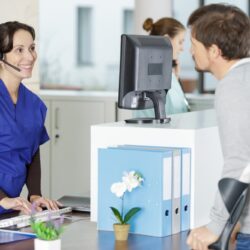Age brings health problems, which necessitates more medical attention. As the baby boomer population ages, individuals are more prone to acquire chronic diseases and age-related health issues that need medical treatment. According to the U.S. Census Bureau, the number of all boomers in America will be 65 years and over. This growth in the older population will place tremendous strain on the healthcare system since they will demand more regular medical care and treatments.
Plus, because today’s seniors are living longer than previous generations, they will require healthcare for a longer length of time. As a result, as the baby boomer population ages, there is an increasing requirement for healthcare professionals, hospitals, and other clinical facilities to be able to satisfy the demand for medical treatment.
As the baby boomer generation ages, there will be a greater need for medical care due to an increasing prevalence of age-related health conditions, longer life expectancy, and a bigger population of seniors. It is critical that healthcare systems are ready to handle this demand and deliver high-quality treatment to this population.
What Are the Benefits of Remote Healthcare for Patients?
Remote healthcare, also known as telemedicine or telehealth, offers a number of advantages for patients. For example, it is often more convenient and cost-effective than traveling to in-person appointments. It is frequently more convenient and cost-effective than traveling to in-person sessions, for example. Remote healthcare allows patients, particularly those who reside in places with a scarcity of healthcare practitioners or experts, to more readily receive healthcare services. This is especially crucial for people who have chronic diseases that need continuing treatment.
Remote healthcare can provide patients with more privacy, especially if they are uncomfortable disclosing personal or sensitive medical information in public. Also, by making it simpler for people to get medical treatment and connect with their healthcare professionals, remote healthcare can boost patient engagement. This may result in enhanced patient satisfaction and improved health outcomes.
What Are the Benefits of Remote Healthcare for Providers?
Telemedicine provides various benefits to healthcare practitioners. For starters, it can boost healthcare practitioners’ efficiency by lowering the time spent on administrative chores and maximizing the number of patients they can see during regular work hours. Practitioners may see more patients and devote more time to delivering high-quality patient care.
Remote healthcare also enables medical practitioners to access a wider patient population, reaching those who live in remote or rural places. This can assist them in expanding their practice and increasing earnings. Plus, there are arguments to be made for the addition of telemedicine to help practices improve patient outcomes, reduce costs, increase flexibility, and improve work-life balance for staff.
How Remote Services Can Solve the Baby Boomer Demand on Healthcare
The delivery of healthcare is evolving, and the baby boomer age stands to gain the most. These are some ways that remote healthcare is addressing the main issues that this aging population is dealing with:
- Healthcare Access: Many baby boomers live in rural or isolated locations with limited access to healthcare. They may now get medical care from the comfort of their own homes thanks to remote healthcare. People can connect with their healthcare professionals via video conferencing, phone conversations, or even text messaging.
- Convenience: As baby boomers age, it becomes increasingly difficult to leave the house. Remote healthcare relieves patients of the need to go to appointments, which can be particularly difficult for people with mobility concerns. Patients may obtain medical treatment without needing to step outside their homes, making it easier and less stressful.
- Better Health Outcomes: Remote services allow medical practitioners to carefully monitor patients, which can result in early intervention and improved health results. It also allows doctors to more quickly track patient progress and make appropriate changes to treatment plans.
- Cost Savings: Because it reduces the need for doctor’s visits and decreases travel costs, remote healthcare is frequently cheaper than in-person treatment. This is especially crucial for older adults who are retired and living on fixed incomes.
- Greater Independence: Remote healthcare can help baby boomers who require assistance with daily life tasks preserve their freedom. Caregivers may stay in touch, without being physically there, allowing seniors to age in place longer, rather than needing to transfer into a round-the-clock care facility.
Remote healthcare is a game-changer for the baby boomer generation, providing improved access to healthcare, convenience, better health outcomes, cost savings, and increased independence. As technology continues to advance, remote healthcare will only become more important in the years to come.
Remote Healthcare Works for So Many Medical Fields
Telemedicine is used in a variety of medical specialties. Here are some examples of how telemedicine is used in different medical specialties:
- Psychiatry: Remote services allow mental health specialists to give remote care to patients suffering from mental illnesses such as anxiety, depression, and post-traumatic stress disorder. Platforms like BetterHealth and TalkSpace have been growing in popularity, in fact, as more people choose to engage in therapy from the comfort of their own homes, where they can avoid the stigma associated with mental illness.
- Dermatology: Dermatologists can detect and treat skin problems remotely because to advances in technology. Individuals can send images of their skin problem to their dermatologist for an evaluation and treatment plan.
- Cardiology: With telehealth, specialists may remotely monitor patients with cardiac diseases such as hypertension or heart failure and alter treatment programs as needed. Wearable devices can be used by patients to monitor their heart rate, blood pressure, and other vital indicators, which can then be sent to their cardiologist for examination.
- Neurology: E-visits support neurologists in monitoring neurological conditions, such as migraines, seizures, and Parkinson’s disease, remotely. Patients can use video conferencing to communicate with their neurologist, who can provide a diagnosis and treatment plan.
- Oncology: Working remotely, oncologists can track the vital signs of patients with cancer, including chemotherapy treatment and side effects.
- Primary Care: Telemedicine is increasingly being used by physicians to provide remote consultations, diagnose and treat common medical conditions, and provide ongoing care for chronic conditions.
Related article: 8 Tips for Medical Practitioners Transitioning to Telehealth.
Medical Answering Services Support Remote Healthcare
Learn more about PatientCall’s answering services for doctors’ offices, medical facilities and assisted living centers, working both in-person and via telehealth.







